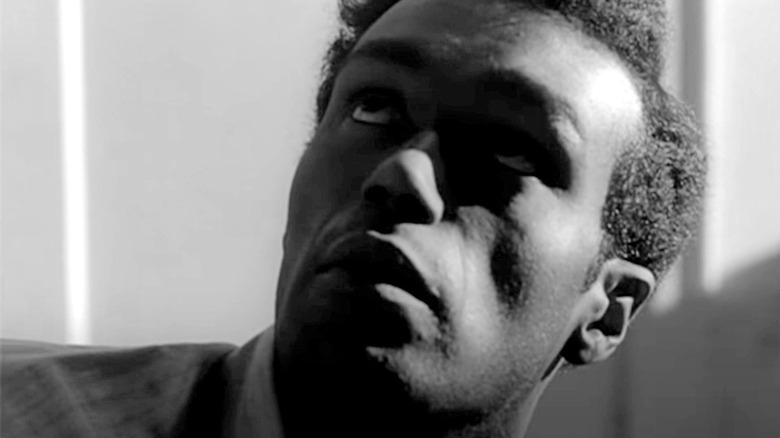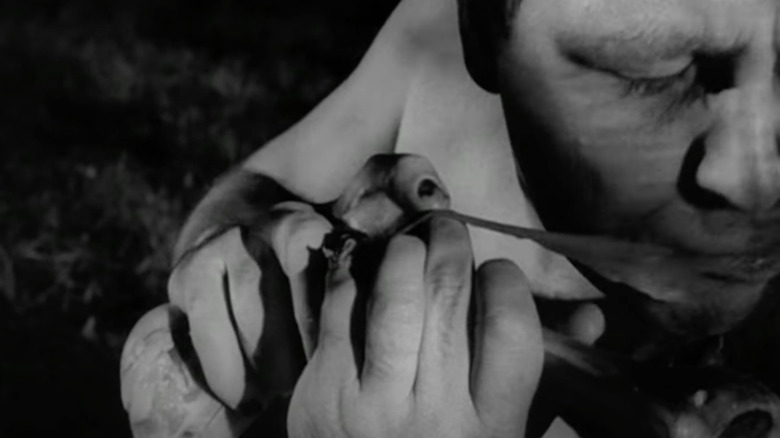
Over the years, George Romero's "Night of the Living Dead" has been the subject of countless homages, full-on remakes, and critical analyses. In October 2021, a new animated version of it came to home media, and that's just one example of how it's the gift that keeps on shambling. Because its distributor forgot to add a copyright notice to it, Romero's original 1968 film is now in the public domain. It's also in the National Film Registry and has its place in history as well.
"Night of the Living Dead" wasn't the first of its kind, but it was instrumental in jump-starting a new sub-genre of horror: the zombie movie. Romero looked to Richard Matheson's 1954 novel "I Am Legend" for inspiration, long before Will Smith ever fought Darkseekers in the loose film adaptation of the same book. Matheson's post-apocalyptic vampires became Romero's world-ending zombies, so you could almost say zombies are vampire offshoots -- the flip side of an unholy communion where the undead will eat the flesh and drink the blood of hapless human victims.
Zombies also draw inspiration from Haitian folklore, but if nothing else, "Night of the Living Dead" is often viewed as the starting point for contemporary zombie films with contemporary themes. The movie came during a time of great social upheaval in the 1960s, and it wasn't always such a stone-cold classic in people's minds.
A Human Barbecue And Death By Daughter

Made on a scrappy budget of $114,000, "Night of the Living Dead" still stands as one of the most successful independent films ever made. As The Take observes, it pushed the envelope of onscreen violence in ways that might seem quaint now, but that were shocking to audiences at the time. This is one reason why it was so controversial.
As the zombie apocalypse unfolded in and around a Pennsylvania farmhouse, a new level of gore opened up, with the taboo of cannibalism lingering in the background. This is nowhere more evident than the scene where zombies descend en masse on a truck, reaching for the remains of two young lovers who have burned to death inside. The zombies wander off with their pieces of cooked human meat and the camera shows them in close-up as they chow down on barbecued body parts.
The film also shows a zombified little girl named Karen devouring her father and killing her mother with a trowel. This was decades before the "Karen" meme entwined the name in everyday racial microaggressions, though racial matters go to the heart of what made "Night of the Living Dead" so controversial.
Romero's film put a Black man in a house with white people and made him the hero, blowing up the butler stereotype and the incipient cliché of a horror film where the expendable Black character dies first. It showed the forceful protagonist, Ben (played by Duane Jones), punching white men and killing white zombies. Yet the movie's racial dynamics go unspoken in the script. It's all in the subtext.
Night Of The Living Dead's Racial Dynamics
In the documentary "Horror Noire," available to stream on Shudder and AMC+, Tony Todd — Candyman himself — revealed that Romero had told him, "The role [of Ben] wasn't written Black. Duane just happened to be the best actor to show up on that day." However, casting a Black actor during the civil rights era, a time when protests and social unrest were sweeping the nation, made every bit of conflict between Ben and the other survivors, especially the white beta male, Harry (Karl Hardman, also a co-producer), more racially charged.
"Horror Noire" also reveals that Romero was driving to New York City when he heard the news of Martin Luther King, Jr.'s assassination on the radio. He had the "Night of the Living Dead" film cans in the trunk of his car, complete with an ending where a posse of good old boys misidentify Ben as a zombie and casually gun him down from afar. Years later, Jordan Peele would subvert this ending in "Get Out," knowing that the audience could already mind-map a similar outcome for his own Black protagonist, Chris (Daniel Kaluuya).
In the meantime, Romero's zombie movie — appropriately filmed in black-and-white — envisioned a reality where law enforcement agencies mobilize to "search out and destroy the marauding ghouls," which are coded as Other and subjected to the mob-justice mentality. It played right into memories of lynchings, police brutality and bias, and the real horrors of American history. No wonder the movie was so controversial.
Read this next: The Best Animated Film Of Each Decade
The post Why Night of the Living Dead Was Mired in Controversy After Release appeared first on /Film.
0 Commentaires